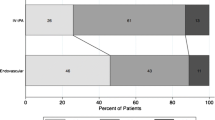Abstract
Acute ischemic stroke is a major cause of morbidity and mortality in industrialized nations. The sequel of stroke ranges from mild to severe disability and even death. Since the impairment may be permanent, the costs to society from work incapacity and the need for long-term care can be high. Additionally, the burden of suffering associated with the disease may have devastating effects on individuals and families.
Following the occlusion of a cerebral vessel, the full extent of the infarction may not become clinically and radiologically apparent until days after. By then, the surrounding watershed zone, or penumbra, either survives or succumbs to necrosis over time. The natural history of this “tissue at risk” is determined by two factors: the collateralization from other vascular territories and the possible occurrence of spontaneous recanalization of the occluded vessel. The current treatment options for acute ischemic stroke are aiming at an early and sustained restoration of flow to the penumbra. The effect of the treatment is therefore time-dependent and the neurologic outcome is a function of the time span between onset of symptoms and recanalization therapy as well as of the recanalization rate associated with a specific treatment.
This report summarizes the results of the major trials on catheter-based interventions, either using thrombolytic drugs or novel mechanical approaches being developed to treat patients with acute ischemic stroke.
Zusammenfassung
Der akute ischämische zerebrovaskuläre Insult ist in den westlichen Industrieländern eine der häufigsten Ursachen von Morbidität und Mortalität. Die Folgen des Insults reichen für den Betroffenen von milden neurologischen Ausfällen über schwerste Pflegebedürftigkeit bis zum Tod mit erheblichen Kosten für das Gesundheitssystem.
Nach einem akuten Verschluss eines hirnversorgenden Gefäßes werden Teile des Parenchyms zunächst über Kollateralen vor der Nekrose bewahrt. Im Laufe von Tagen kann sich dieses Gewebe, die Penumbra, regenerieren, oder es wird untergehen. Dies ist sowohl von der Kollateralversorgung des Gewebes als auch von einer Reperfusion, z.B. durch spontane Thrombolyse, abhängig. Das Ziel der derzeitigen Therapieoptionen ist eine Wiederherstellung der Perfusion der Penumbra durch Rekanalisierung des Gefäßes. Der Therapieerfolg hängt dabei von der Rekanalisierungsrate und der Ischämiezeit der Penumbra bis zur Reperfusion ab.
Dieser Artikel fasst die Ergebnisse der größeren Studien zu katheterbasierten Techniken zusammen und vergleicht die medikamentöse Thrombolyse mit neueren mechanischen Ansätzen zur Thrombektomie in der Behandlung des akuten ischämischen zerebrovaskulären Insults.
Similar content being viewed by others
Author information
Authors and Affiliations
Corresponding author
Rights and permissions
About this article
Cite this article
Gralla, J., Brekenfeld, C., Arnold, M. et al. Acute Stroke: Present and Future of Catheter-Based Interventions. Herz 33, 507–517 (2008). https://doi.org/10.1007/s00059-008-3153-x
Published:
Issue Date:
DOI: https://doi.org/10.1007/s00059-008-3153-x
Key Words:
- Acute ischemic stroke
- Interventional treatment
- Mechanical thrombectomy
- Intraarterial thrombolysis
- Catheter-based interventions




